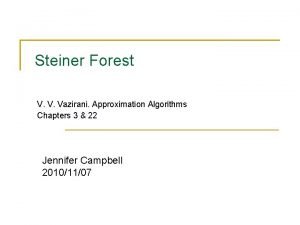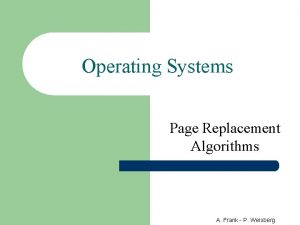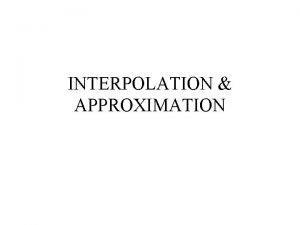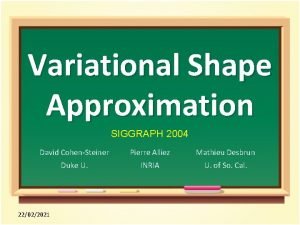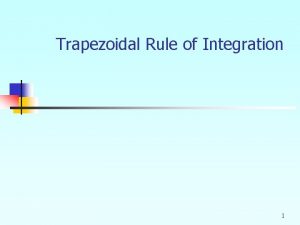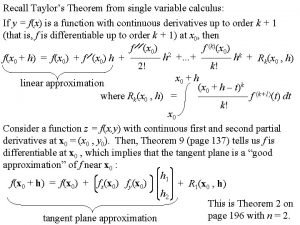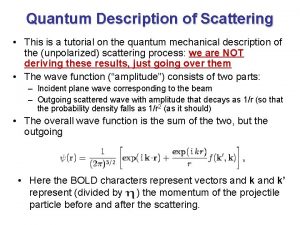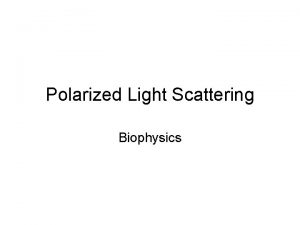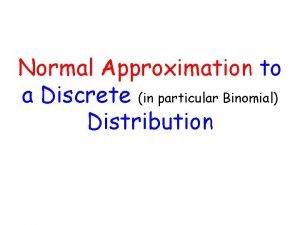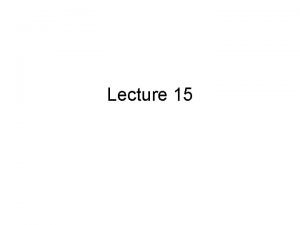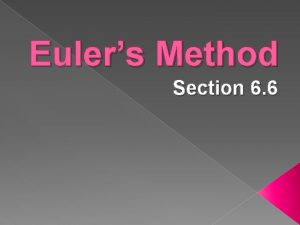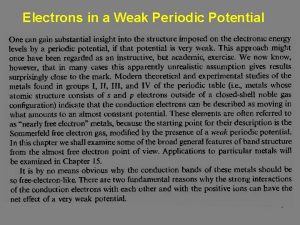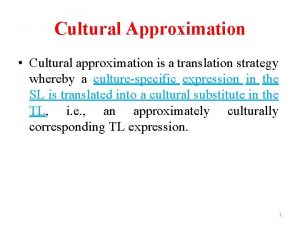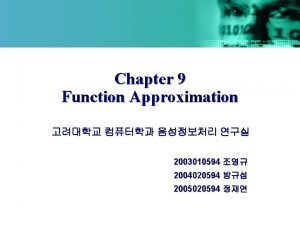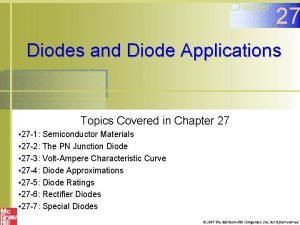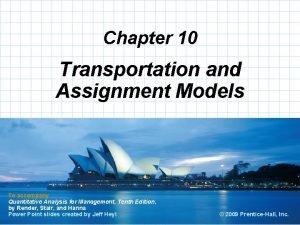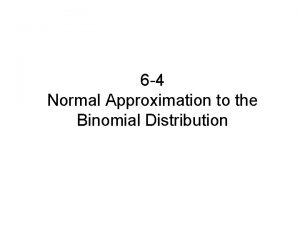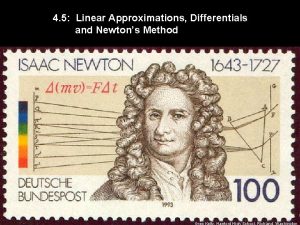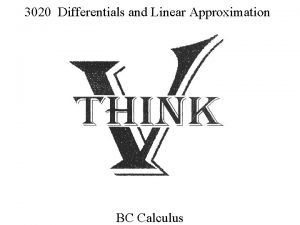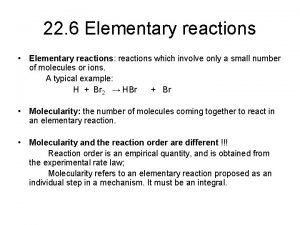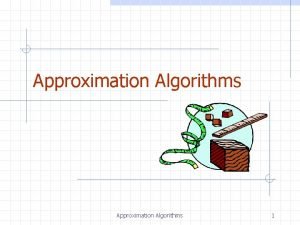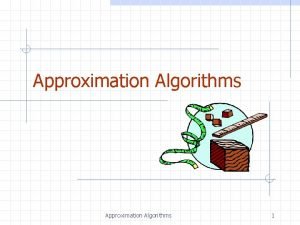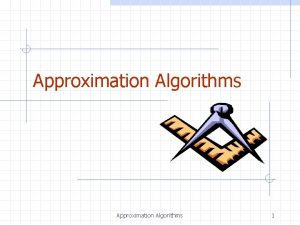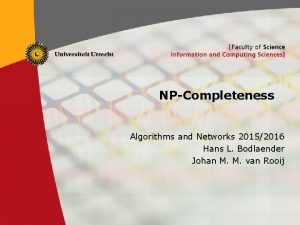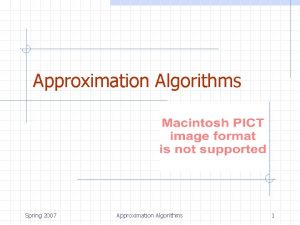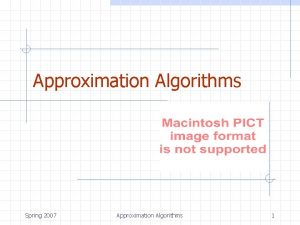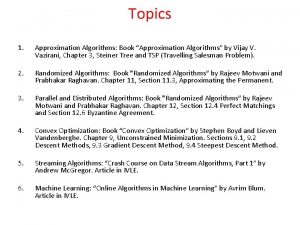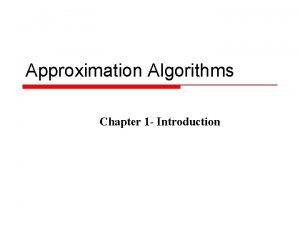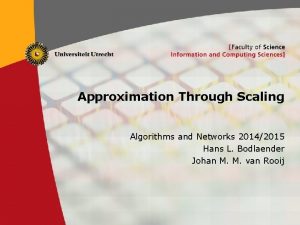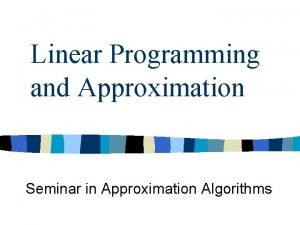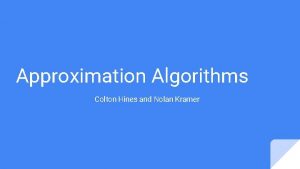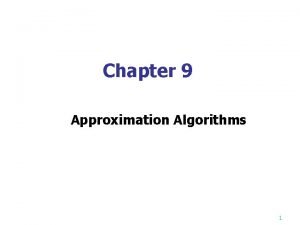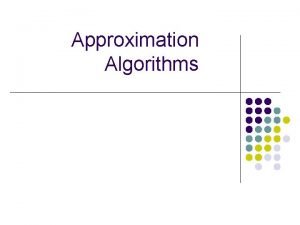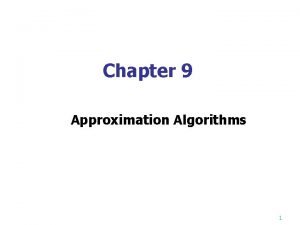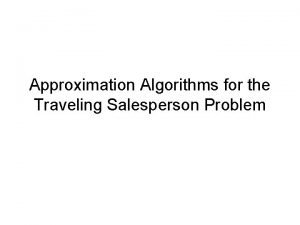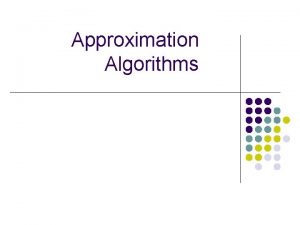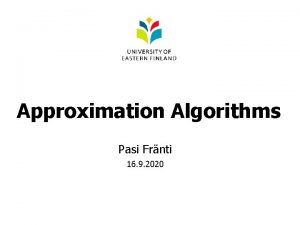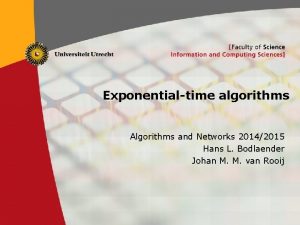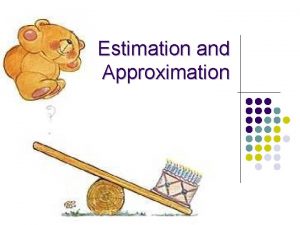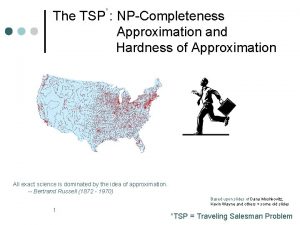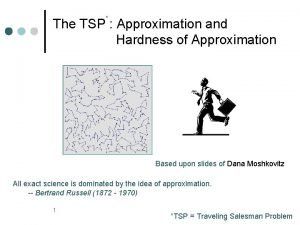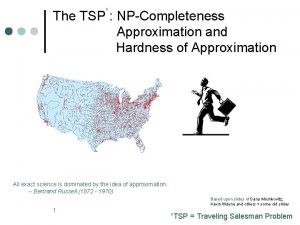Approximation algorithms Algorithms and Networks 20152016 Hans L

























- Slides: 25

Approximation algorithms Algorithms and Networks 2015/2016 Hans L. Bodlaender Johan M. M. van Rooij

What to do if a problem is NP-complete? g We have already seen many options to deal with NP- complete problems. g FTP, special cases, exact exponential-time algorithms, heuristics. g In other courses: local search, ILP, constraint programming, … g Approximation algorithms are one of these options. g An approximation algorithm is a heuristic with a performance guarantee. g We consider polynomial-time approximation algorithms. g Non-optimal solutions, but with some performance guarantee compared to the optimal solution. g Also useful as a starting point for other approaches: g Local search, branch and bound. 2

Different forms of approximation algorithms (outline of lecture) Qualities of polynomial-time approximation algorithms: 1. Absolute constant difference. Ø |OPT – ALG| · c 2. APX: Constant-factor approximation. Ø Approximation ratio: ALG/OPT · c for minimisation problems. Ø Approximation ratio: OPT/ALG · c for maximisation problems. 3. f(n)-APX : Approximation by a factor of f(n). Ø f(n) depends only one the size of the input. 4. PTAS: Polynomial-time approximation scheme. Ø Approximation ratio 1+² for any ² > 0, while the algorithm runs in polynomial time for any fixed ². 5. FPTAS: Fully polynomial-time approximation scheme. Ø Approximation ratio 1+² for any ² > 0, while the algorithm runs in time polynomial in n and 1/². 3

Absolute constant difference g Algorithms that run in worst-case polynomial time, with: g |OPT – ALG| · c g Example: Planar graph colouring. g Algorithm that tests 1 and 2 -colourability and if no solution found always outputs 4. g Algorithm has an error of at most 1. g These examples are rare. g Not so difficult to show: g TSP cannot be approximated by a constant factor unless P NP. 4

Constant-factor approximation g Approximation ratio: g ALG/OPT · c for minimisation problems. g OPT/ALG · c for maximisation problems. g Ratio always bigger or equal to 1. g Class of problems with a constant factor approximation algorithm: APX. g Notions of APX-completeness also exist. g Examples of constant-factor approximation algorithms from earlier lectures: g 2 -approximations: MST based algorithms for metric TSP. (TSP with triangle inequality). g 1. 5 -approximation: Christofides algorithm for metric TSP. 5

Approximation for vertex cover Approximation algorithm for vertex cover: 1. Let E’ = E, C = ; 2. While E’ ; 1. Let {u, v} be any edge from E’ 2. C = C [ {u, v} 3. Remove every edge incident to u of v from E’. 3. Return C g Runs in polynomial time. g Returns a vertex cover. g How good is this vertex cover? 6

2 -approximation for vertex cover Theorem: g The algorithm on the previous slide is a 2 -approximation. Proof: g Let A be the set of edges which endpoints we picked. g OPT ¸ |A|, because every edge in A must be covered. g ALG = 2|A| · 2 OPT, hence ALG/OPT · 2. 7

Approximation by a factor of f(n) g Approximation ratio of f(n). g Approximation ratio depends on the size of the input (and can be very bad) Set Cover g Given: finite set U and a family F of subsets of U. g Question: Does there exists a subset C of F of size at most k such that [S 2 C S = U? Greedy algorithm: g While U ; : g Select S 2 F that maximises |S Å U| g Add S to C and let U : = U S 8

An (ln(n)+1)-approximation algorithm for se cover Theorem: g The greedy set cover algorithm is an (ln(n)+1)-approximation. Proof: g The algorithm runs in polynomial time and returns a set cover. g Let Si be the ith set from F picked by the algorithm. g We assign cost cx to elements from x: g Let x be firstly covered by set Si while running the algorithm. g And, let Xi = Si (S 1 [ S 2 [. . . [ Si-1) g Define: cx = 1 / |Xi|. g Now we have: g. . . 9

Proof of the (ln(n)+1)-approximation algorithm for set cover g The nth Harmonic number H(n) is defined as: g From mathematics (bounding using integrals): g On the next two slides, we will prove that for any S 2 F: g From this we derive our approximation ratio: g Where C* is the optimal set cover. 10

Bounding the cost of any set S g What remains is to prove that for any S 2 F: g Remind: g If x firstly covered by Si, then cx = 1 / |Xi| g Where: Xi = Si (S 1 [ S 2 [. . . [ Si-1) g For any S 2 F, let ui be the number of uncovered items in S when the algorithm selects Si. g Take the smallest value k s. t. uk = 0. g With the last equality due to the selection by the algorithm. g Then. . . 11

Bounding the cost of any set S g To prove: g Last slide: g Thus: g Remind: g Q. E. D. 12

PTAS g A Polynomial Time Approximation Scheme is an algorithm, that gets two inputs: the “usual” input X, and a real value e>0. g For each fixed e>0, the algorithm g Uses polynomial time g Is an (1+e)-approximation algorithm 13

FPTAS g A Fully Polynomial Time Approximation Scheme is an algorithm, that gets two inputs: the “usual” input X, and a real value e>0, and g For each fixed e>0, the algorithm g Is an (1+e)-approximation algorithm g The algorithm uses time that is polynomial in the size of X and 1/e. 14

Example: Knapsack g Given: n items each with a positive integer weight w(i) and integer value v(i) (1 ≤ i ≤ n), and an integer B. g Question: select items with total weight at most B such that the total value is as large as possible. 15

Dynamic Programming for Knapsack g Let P be the maximum value of any item. g We can solve the problem in O(n 2 P) time with dynamic programming: g Tabulate M(i, Q): minimum total weight of a subset of items 1, …, i with total value Q for Q at most n. P g M(0, 0) = 0 g M(0, Q) = ∞, if Q>0 g M(i+1, Q) = min{ M(i, Q), M(i, Q-v(i+1)) + w(i+1) } g This algorithm is clearly correct and runs in the given time. 16

Scaling for Knapsack g Take input for knapsack g Throw away all items that have weight larger than B (they g g 17 are never used) Let c be some constant Build new input: do not change weights, but set new values v’(i) = ë v(i) / c û Solve scaled instance with DP optimally Output this solution: approximates solution for original instance

The Question is…. g How do we set c, such that g Approximation ratio good enough g Polynomial time 18

Approximation ratio g Consider optimal solution Y for original problem, value OPT g Value in scaled instance: at least OPT/c – n g At most n items, for each v(i)/c - ë v(i)/c û <1 g So, DP finds a solution of value at least OPT/c –n for scaled problem g So, value of approximate solution for original instance is at least c*(OPT/c –n) = OPT - nc 19

Setting c g Set c = e. P/(2 n) g This is an FPTAS g Running time: g Largest value of an item is at most P/c = P / (e. P/(2 n)) = 2 n/e. g Running time is O(n 2 * 2 n/e) = O(n 3/e) g Approximation: … next 20

e-approximation g Note that each item is a solution (we removed items with g g 21 weight more than B). So OPT ≥ P. Algorithm gives solution of value at least: OPT – nc = OPT – n(e P / (2 n) ) = OPT – e/2 P OPT / (OPT – e/2 P)≤ OPT / (OPT – e/2 OPT) = 1/(1 -e/2) ≤ 1+e QED.

2 -approximation for minimum weight vertex cover g Minimum weight vertex cover: g Vertex cover where each vertex has a weight. g We look for the minimum weight vertex cover. g 2 -approximation for vertex cover no longer works. g We may select very heavy vertices using that algorithm. g Consider the following ILP: g It’s LP relaxation is ILP with the last constraint replaced by: g 0 · x(v) · 1 22

2 -approximation algorithm for minimum weight vertex cover Algorithm: g Compute the optimal solution to the LP relaxation. g Output all v with x(v) ¸ ½. g Algorithm runs in polynomial time. g Linear programming can be solved in polynomial time. g Not by the simplex algorithm!! g Ellipsoid method / interior point methods. g Algorithm returns a vertex cover. g For every edge, sum of incident vertices at least 1. g Hence at least one of the vertex variables at least ½. 23

Proof of 2 -approximation algorithm for minimum weight vertex cover g Let z* be the solution to the LP. g Because any vertex cover is a solution to the LP we have: g Also, we can bound ALG in terms of z*: g Hence: g QED 24

Conclusion Qualities of polynomial-time approximation algorithms: 1. Absolute constant difference. Ø Planar graph colouring. 2. APX: Constant-factor approximation. Ø TSP with triangle inequality. Ø Vertex cover. 3. f(n)-APX : Approximation by a factor of f(n). Ø Set cover. 4. PTAS: Polynomial-time approximation scheme. 5. FPTAS: Fully polynomial-time approximation scheme. Ø Scaling for Knapsack. 25
 Vazirani approximation algorithms
Vazirani approximation algorithms Lru approximation page replacement algorithm
Lru approximation page replacement algorithm Approximation algorithms for np-hard problems
Approximation algorithms for np-hard problems Datagram network vs virtual circuit network
Datagram network vs virtual circuit network Routing algorithms in computer networks
Routing algorithms in computer networks Basestore iptv
Basestore iptv Interpolation and approximation of curves in cad
Interpolation and approximation of curves in cad Variational shape approximation
Variational shape approximation Trapezoidal approximation formula
Trapezoidal approximation formula Trapezoidal approximation
Trapezoidal approximation Taylor theorem
Taylor theorem Yukawa potential
Yukawa potential Transversality condition
Transversality condition Divms uiowa
Divms uiowa Flat earth map projection
Flat earth map projection Steady state approximation in chemical kinetics
Steady state approximation in chemical kinetics Eulers.method
Eulers.method Empty lattice approximation
Empty lattice approximation Cultural approximation
Cultural approximation Continuous least squares approximation
Continuous least squares approximation First approximation of diode
First approximation of diode Stepping stone method
Stepping stone method Normal approximation calculator
Normal approximation calculator When does newton's method fail
When does newton's method fail Linearization formula
Linearization formula The gas phase decomposition of acetic acid at 1189 k
The gas phase decomposition of acetic acid at 1189 k
